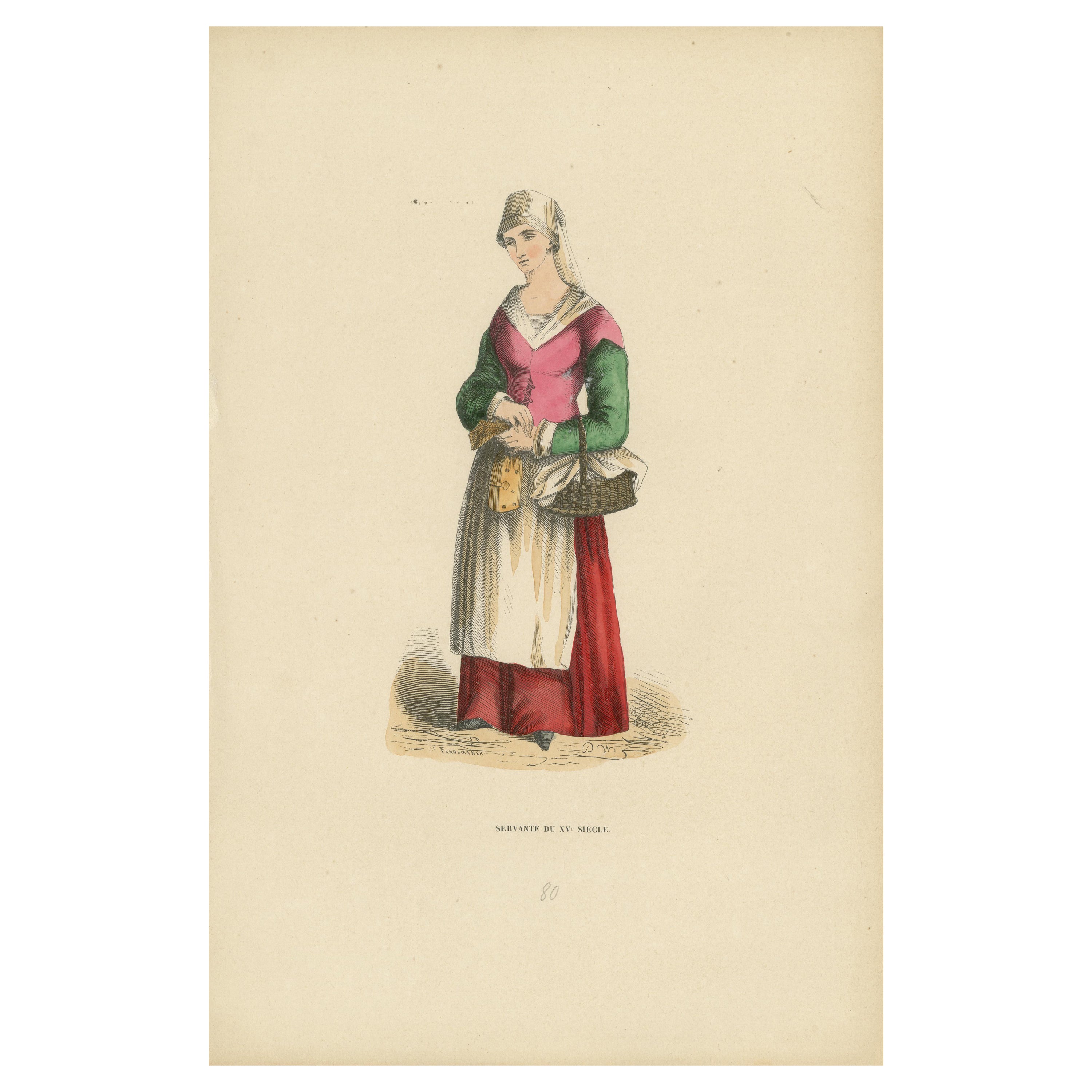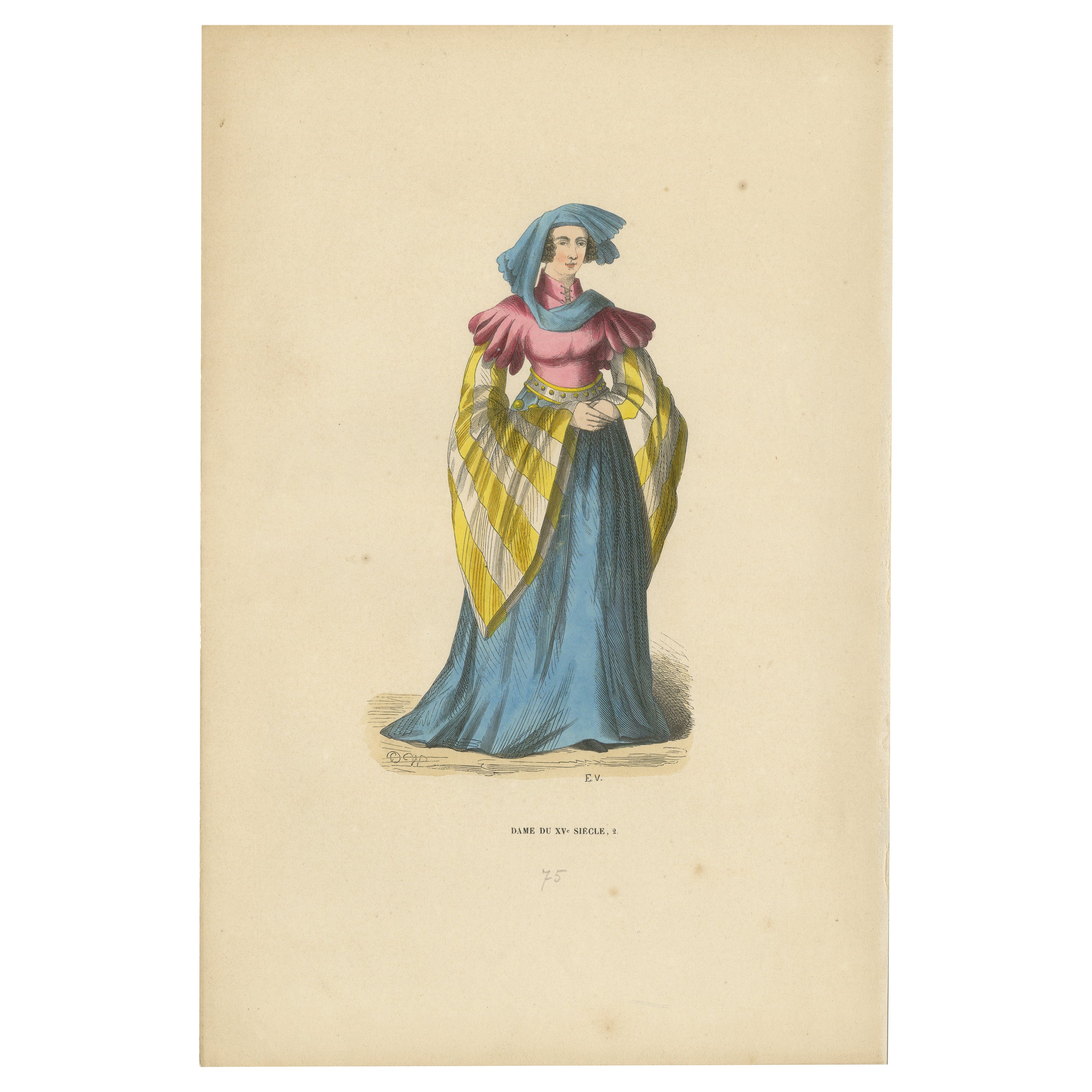Items Similar to Civilian Costume at the End of the 15th Century, 1847
Want more images or videos?
Request additional images or videos from the seller
1 of 6
Civilian Costume at the End of the 15th Century, 1847
About the Item
Title: "Civilian Costume at the End of the 15th Century"
Description: The image is a print from a series the "Costume du Moyen Age" dated 1847, and titled "Costume Civil de la Fin du XVe Siècle," which translates to "Civilian Costume at the End of the 15th Century." It showcases a man of status, possibly a noble or a wealthy burgher, standing in a poised and confident manner.
He is attired in an ornate cloak covered in a complex pattern of fleur-de-lis and cross motifs, indicative of wealth and possibly a connection to royalty or high social rank. The cloak is open at the front to reveal a blue doublet with a belt, and he wears red hose—a fashion staple of the late medieval period. His footwear is also red, which stands out against the more subdued tones of his outfit.
On his head, he sports a fur-trimmed hat, adding to the luxuriousness of his attire. In one hand, he holds a long staff, which serves as both a walking aid and a symbol of authority. His other hand rests on the hilt of a dagger, further indicating his readiness to defend his status or engage in the political or civic matters of his time.
The artist has skillfully rendered the textiles and accessories with great care, emphasizing the fashion and social cues of the late 15th-century European society.
The colors have a nice glow over them. Historically, egg whites, known as glair, and sometimes egg yolk were indeed used in illumination and painting, particularly in manuscripts, to give colors a brighter appearance and to add a sheen or gloss to the work. This technique was quite common during the Middle Ages and into the Renaissance.
Egg whites can be applied as a varnish over pigments to enhance their brightness and to protect the colors. This application could make the colors appear more vivid and also add a slight glossy sheen to the surface of the image.
Egg yolk, on the other hand, was commonly used as a binding agent in paint. It forms the basis of tempera paint, a medium that was widely used before the advent of oil painting. Egg yolk helps to create a durable and long-lasting color that adheres well to various surfaces.
In the context of the print from 1847, it's less likely that egg whites or yolks were used directly on the print, as by that time, commercial printing processes would have been more advanced and less reliant on such manual methods. However, if this print is a representation of an earlier style or is meant to mimic the appearance of hand-painted manuscripts, the original artists might have employed techniques or materials that gave a similar effect to those achieved with egg-based binders and varnishes.
- Dimensions:Height: 10.63 in (27 cm)Width: 7.09 in (18 cm)Depth: 0 in (0.02 mm)
- Materials and Techniques:
- Period:
- Date of Manufacture:1847
- Condition:Good. Overal light toning and light soiling but the image itself clean and hand-colored almost 200 years ago and still in expliciet colors. Aged paper with typically warm, yellowish-brown hue, mostly around the edges. Study the images carefully.
- Seller Location:Langweer, NL
- Reference Number:
About the Seller
5.0
Platinum Seller
These expertly vetted sellers are 1stDibs' most experienced sellers and are rated highest by our customers.
Established in 2009
1stDibs seller since 2017
1,929 sales on 1stDibs
Typical response time: <1 hour
- ShippingRetrieving quote...Ships From: Langweer, Netherlands
- Return PolicyA return for this item may be initiated within 14 days of delivery.
More From This SellerView All
- Noble Falconer: Lady of the 15th Century, 1847Located in Langweer, NLTitle: "Noble Falconer: Lady of the 15th Century" Description: This print captures the noble pastime of falconry, a sport historically associated with the aristocracy, through the p...Category
Antique 1840s Prints
MaterialsPaper
- French Maid of the 15th Century: Daily Grace, Published in 1847Located in Langweer, NLTitle: "Maid of the 15th Century: Daily Grace" Description: This print portrays a servant or maid from the 15th century, captured in a moment of stillness, perhaps while going about...Category
Antique 1840s Prints
MaterialsPaper
- Maternal Instruction in the 15th Century: A Noblewoman Teaching a Child, 1847Located in Langweer, NL"Dame de la Fin du XV Siècle" (Lady of the Late 15th Century) Description: This is a hand-colored print from the 1847 collection "Costume du Moyen Age," titled "Dame de la Fin du XV Siècle." The image beautifully captures a moment of tenderness and learning between a lady of the late 15th century and a child. The lady is seated, wearing an exquisite blue gown adorned with a floral pattern, which is likely to be a representation of the sumptuous fabrics worn by the nobility during that era. Her dress has a high waistline and full sleeves, a fashion typical of the late medieval period, and the neckline is accented with gold, highlighting her status. She is cloaked in a green mantle...Category
Antique 1840s Prints
MaterialsPaper
- 15th Century Elegance: Lady of the Court, Engraved and Published in 1847Located in Langweer, NLTitle: "15th Century Elegance: Lady of the Court" Description: This print presents a lady of the 15th century, elegantly attired in the fashion of the European high nobility. Her dr...Category
Antique 1840s Prints
MaterialsPaper
- Vigilance in Blue: 15th Century Military Garb, 1847Located in Langweer, NLTitle: "Vigilance in Blue: 15th Century Military Garb" Description: This original handcolored historical illustration presents a military figure from the 15th century, clad in an or...Category
Antique 1840s Prints
MaterialsPaper
- Antique Print of a Travel Costume, 15th Century, by Bonnard, 1860Located in Langweer, NLAntique print titled ‘Costume de Voyage, XVe Siecle.’ Original antique print of a Travel Costume, 15th century. This print originates from 'Costumes historiques de femmes du XIII, XI...Category
Antique Mid-19th Century Prints
MaterialsPaper
You May Also Like
- 1460 c Israhel van Meckenem, Burial of Christ, metalcut, mid-15th CenturyLocated in Norwich, GBAttributed to the "Meister der Berliner Passion" from his Kleine Passion. It is now considered almost certain that the Meister der Berliner Passion was in fact Israhel van Meckenem ...Category
Antique 15th Century and Earlier Dutch Renaissance Prints
MaterialsPaper
- The Holy Land at the Time of Jesus: A 17th Century Dutch Map by VisscherBy Nicolaes Visscher IILocated in Alamo, CAThis detailed Dutch map entitled "Het Beloofe de Landt Canaan door wandelt van onsen Salichmaecker Iesu Christo, nessens syne Apostelen" by Nicolaes Visscher was published in Amsterd...Category
Antique Mid-17th Century Dutch Maps
MaterialsPaper
- 'The Market Square at Pirna' - Antique Engraving - Germany - 18th/19th CenturyLocated in Chatham, ON'The Market Square at Pirna' (After Bernardo Bellotto) - Antique copper plate engraving on paper - titled (in German) in pencil lower left - signe...Category
Antique Early 19th Century German Renaissance Prints
MaterialsPaper
- Pieter Van Laer "Les Enfants" Engraving End of 18th CenturyBy (circle of) Pierre MignardLocated in Beuzevillette, FRBeautiful engraving by Louis Gareau after a painting by Pieter Van Laer entitled "The children". The painting was in the gallery of His Serene Highness Monseigneur Le Duc D'Orleans The scene represents children playing in ruins. The ruins are widely present and structure the painting, they recall the archaeological discoveries made at that time. Pieter Van Laer is a 17th century Dutch painter, draftsman and printmaker. His style is imitated by several artists called "bamboccianti". He left for France, in order to make his study trip. He then settled in Italy, more precisely in Rome, where he ended up settling. He belonged to a brotherhood of Dutch painters established in Italy. Italian influences are found in its decorations. He painted numerous scenes from popular life with a Dutch character (festive scenes, game scenes...Category
Antique 19th Century Dutch Picture Frames
MaterialsPaper
- Anatomical Print Depicting Birds, P. Dybdahls, Norway End of 19th CenturyLocated in Milan, ITA chromolithographic print on paper by P. Dybdahls, depicting an anatomical table (Pl. 33) of birds. Fir wood frame, walnut briar veneer, with gilded ramin wood edge. H. Aschehoug & ...Category
Antique Late 19th Century Norwegian Prints
MaterialsWalnut, Paper
- An anatomical, depicting birds, P. Dybdahls, Norway end of 19th centuryLocated in Milan, ITA chromolithographic print on paper by P. Dybdahls, depicting an anatomical table (Pl. 39) of birds. Fir wood frame, walnut briar veneer, with gilded ramin wood edge. H. Aschehoug & ...Category
Antique Late 19th Century Norwegian Prints
MaterialsWalnut, Paper





